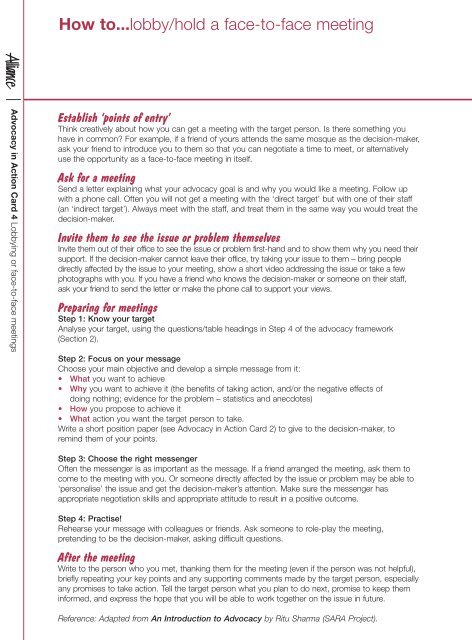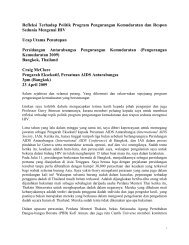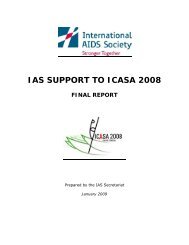Advocacy in Action - International AIDS Society
Advocacy in Action - International AIDS Society
Advocacy in Action - International AIDS Society
You also want an ePaper? Increase the reach of your titles
YUMPU automatically turns print PDFs into web optimized ePapers that Google loves.
How to...lobby/hold a face-to-face meet<strong>in</strong>g<br />
<strong>Advocacy</strong> <strong>in</strong> <strong>Action</strong> Card 4 Lobby<strong>in</strong>g or face-to-face meet<strong>in</strong>gs<br />
Establish ‘po<strong>in</strong>ts of entry’<br />
Th<strong>in</strong>k creatively about how you can get a meet<strong>in</strong>g with the target person. Is there someth<strong>in</strong>g you<br />
have <strong>in</strong> common? For example, if a friend of yours attends the same mosque as the decision-maker,<br />
ask your friend to <strong>in</strong>troduce you to them so that you can negotiate a time to meet, or alternatively<br />
use the opportunity as a face-to-face meet<strong>in</strong>g <strong>in</strong> itself.<br />
Ask for a meet<strong>in</strong>g<br />
Send a letter expla<strong>in</strong><strong>in</strong>g what your advocacy goal is and why you would like a meet<strong>in</strong>g. Follow up<br />
with a phone call. Often you will not get a meet<strong>in</strong>g with the ‘direct target’ but with one of their staff<br />
(an ‘<strong>in</strong>direct target’). Always meet with the staff, and treat them <strong>in</strong> the same way you would treat the<br />
decision-maker.<br />
Invite them to see the issue or problem themselves<br />
Invite them out of their office to see the issue or problem first-hand and to show them why you need their<br />
support. If the decision-maker cannot leave their office, try tak<strong>in</strong>g your issue to them – br<strong>in</strong>g people<br />
directly affected by the issue to your meet<strong>in</strong>g, show a short video address<strong>in</strong>g the issue or take a few<br />
photographs with you. If you have a friend who knows the decision-maker or someone on their staff,<br />
ask your friend to send the letter or make the phone call to support your views.<br />
Prepar<strong>in</strong>g for meet<strong>in</strong>gs<br />
Step 1: Know your target<br />
Analyse your target, us<strong>in</strong>g the questions/table head<strong>in</strong>gs <strong>in</strong> Step 4 of the advocacy framework<br />
(Section 2).<br />
Step 2: Focus on your message<br />
Choose your ma<strong>in</strong> objective and develop a simple message from it:<br />
• What you want to achieve<br />
• Why you want to achieve it (the benefits of tak<strong>in</strong>g action, and/or the negative effects of<br />
do<strong>in</strong>g noth<strong>in</strong>g; evidence for the problem – statistics and anecdotes)<br />
• How you propose to achieve it<br />
• What action you want the target person to take.<br />
Write a short position paper (see <strong>Advocacy</strong> <strong>in</strong> <strong>Action</strong> Card 2) to give to the decision-maker, to<br />
rem<strong>in</strong>d them of your po<strong>in</strong>ts.<br />
Step 3: Choose the right messenger<br />
Often the messenger is as important as the message. If a friend arranged the meet<strong>in</strong>g, ask them to<br />
come to the meet<strong>in</strong>g with you. Or someone directly affected by the issue or problem may be able to<br />
‘personalise’ the issue and get the decision-maker’s attention. Make sure the messenger has<br />
appropriate negotiation skills and appropriate attitude to result <strong>in</strong> a positive outcome.<br />
Step 4: Practise!<br />
Rehearse your message with colleagues or friends. Ask someone to role-play the meet<strong>in</strong>g,<br />
pretend<strong>in</strong>g to be the decision-maker, ask<strong>in</strong>g difficult questions.<br />
After the meet<strong>in</strong>g<br />
Write to the person who you met, thank<strong>in</strong>g them for the meet<strong>in</strong>g (even if the person was not helpful),<br />
briefly repeat<strong>in</strong>g your key po<strong>in</strong>ts and any support<strong>in</strong>g comments made by the target person, especially<br />
any promises to take action. Tell the target person what you plan to do next, promise to keep them<br />
<strong>in</strong>formed, and express the hope that you will be able to work together on the issue <strong>in</strong> future.<br />
Reference: Adapted from An Introduction to <strong>Advocacy</strong> by Ritu Sharma (SARA Project).
















